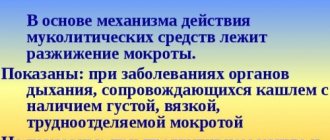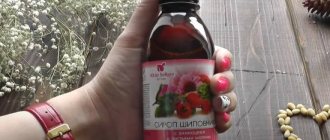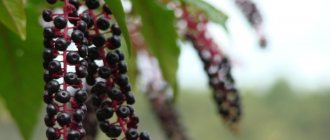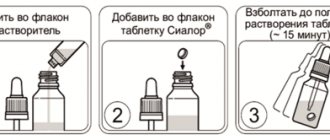Compound
This is a medicine with a combined composition, the main active ingredients of which are essential anise oil and a 10% ammonia solution. Thanks to these components, the drug has a double effect.
| Active substances | Excipients | |
| Essential anise oil | Ammonia | Ethanol |
| 2.81 g | 15 ml | About 100 ml |
The oil is a natural antiseptic, as it contains phenolic compounds and carboxylic acids. When taken orally, the ether activates bronchial secretions and stimulates the process of mucus evacuation from the respiratory tract.
Ammonia makes sputum more viscous, making it easier to expectorate. It affects both the ciliated epithelium of the bronchi and the nerve endings, causing a reflex reaction of the body that promotes coughing up sputum.
What does it help with?
Anise for cough is useful in itself, but in drops its effect is enhanced. This happens thanks to ammonia. It doesn’t matter what kind of cough a person takes medicine for. When dry, it promotes the production of sputum, when wet, it removes it from the respiratory tract. The medicine heals the mucous membrane of the respiratory system and alleviates the sore throat that occurs during a severe cough. The drug helps with:
- any form of bronchitis;
- bronchogenic pneumonia;
- whooping cough in children;
- inflammation of the throat and larynx;
- dysfunctions of the digestive system.
The advantages of the drops include the absence of flavors and dyes, a small list of contraindications compared to mixtures made from synthetic substances, and a mild effect.
Often, drops of anise and ammonia are used as part of complex therapy to enhance the effectiveness of other mucolytic agents.
Action
Ammonia-anise cough drops have the following effects on the body:
- stabilize the activity of the stomach;
- increase gastrointestinal motility;
- activate the digestive process;
- eliminate increased gas formation;
- increase appetite;
- relieve pain;
- relieve inflammation in the nasopharynx;
- promote the secretion and removal of sputum.
The effect of taking the drug for cough is cumulative. Relief occurs on the first day, but is fully evident around the third day.
Price of ammonia-anise drops, where to buy
You can buy it in pharmacies in Moscow and other cities. The price of the drug in a 25 ml bottle ranges from 27 rubles. up to 44 rub.
- Online pharmacies in RussiaRussia
- Online pharmacies in UkraineUkraine
ZdravCity
- Ammonia-anise drops solution for oral administration, alcohol 25 mlKirovskaya f.f.
98 RUR order - Ammonia-anise drops 25 ml OAO Tverskaya f.f.
97 RUR order
show more
Indications
Indications for use are the following symptoms and diseases:
- dry and wet cough resulting from bronchopulmonary diseases (transfer dry non-productive cough into wet): pneumonia, bronchitis of any etiology, tracheitis, laryngitis, pleurisy, pharyngitis, bronchiectasis, whooping cough;
- chest pain when coughing;
- inflammatory damage to the mucous membrane of the respiratory tract;
- problems with the digestive process, including impaired secretion and motility;
- colic.
Advantages
The advantages of the drug include:
- use during the period of bearing and feeding a child;
- the possibility of using drugs in pediatric practice;
- relatively pleasant taste and smell (not everyone likes it);
- absence of dyes, stabilizers, flavors;
- soft action;
- low price;
- a small number of contraindications.
Directions for use and dosage for cough
The regimen for taking the drug is standard and is described in the instructions that come with the drug. However, when prescribing anise drops, the doctor can adjust the dosage and dosage regimen taking into account the individual condition of the patient.
Before ingestion, the drops should be diluted in a small amount of clean boiled water (for an adult (from 14 years old) about 10-15 drops per 1 tbsp). Those who have used this drug are advised to take it together with refined sugar, dripping the solution onto a cube, but the instructions are silent about this use.
It is dangerous to take the drug in concentrated form, since the alcohol base can cause a burn to the oral mucosa. It is recommended to take the drug 3-4 times a day until lasting improvement. It usually occurs after 7-12 days of treatment.
The figure shows how to take ammonia-anise drops for cough depending on age.
Dosage for a child - 1 drop. for a year of life. Despite the safety of the drug, in pediatric practice it should be used carefully, monitoring the body's reaction. In addition, the drug contains alcohol.
After taking the drug orally, according to the instructions, you need to drink a large amount of warm liquid.
Cough recipes with anise drops
To prepare an effective cough remedy at home, use ammonia-anise drops and cough tablets based on the thermopsis herb. 2 tables thermopsis is ground into powder and poured into a glass. Add a teaspoon of drops and 2 tbsp. water. Take twice a day half an hour before meals, and the third time two hours before bedtime.
Anise drops can also be used effectively in other recipes. For example, they are mixed with syrup based on marshmallow root. This is how a medicine is obtained that is not inferior to expensive drugs made from synthetic components. Separately, decoctions and tinctures are prepared from anise seeds at home.
They are mixed with honey, licorice root or coltsfoot leaves and poured with hot boiling water. Drink warm until complete recovery.
Despite the fact that synthetic and toxic additives are not used in home recipes, permission to treat cough with folk remedies should be obtained from a doctor.
Contraindications
It is necessary to take ammonia-anise drops for cough, taking into account the contraindications:
- increased sensitivity,
- high stomach acidity,
- gastritis,
- stomach or intestinal ulcer.
It is possible to use it for alcoholism, diseases and injuries of the brain, pregnancy and during the period of feeding a child, in pediatrics. However, this must be done with caution. The drug is not prescribed for children under one year of age, and use is not recommended for children under 3 years of age, but is possible.
What to replace
Ammonia-anise cough drops have no structural analogues, but there are many drugs on the market that have a similar effect:
- Breast elixir. Contains licorice extract, anise oil, ammonia and ethanol. The drug has an expectorant effect. Indications for use: respiratory tract diseases (bronchitis, tracheobronchitis, bronchial asthma, pneumonia).
- Mukaltin. Contains marshmallow herb extract, as well as auxiliary components - dioxysuccinic acid, bicarbonate and calcium stearate. Has mucolytic properties. Indications for use: any form of respiratory tract disease. It is used both as an independent drug and as part of complex therapy.
- Ambroxol. The main active ingredient is ambroxol hydrochloride. Auxiliary ingredients: potato starch, magnesium stearate, lactose monohydrate. It has mucolytic and expectorant properties. Indicated for oral administration for diseases of the upper and lower respiratory tract with the formation of sputum.
Users generally respond positively to ammonia-anise drops. Among the advantages are the low price and high effectiveness in the fight against cough, as well as in solving digestive problems. Disadvantages include the presence of contraindications, unpleasant taste and pungent odor.
Side effects
Taking the drug may cause an allergic reaction, manifested by rash, itching, redness and swelling of the mucous membranes. In addition, nausea and vomiting are possible. If these symptoms appear, the next action should be to stop taking the drug. The allergic reaction can be treated with antihistamines.
If the method of application is not followed, a burn to the mucous membrane occurs.
Analogs
Table 1. Indications and contraindications of drugs:
| For respiratory diseases | |||
| Name | Compound | Indications | Contraindications |
| Ascoril | The main active ingredients are bromhexine, guaifenesin, and salbutamol. | Asthma, obstructive bronchitis, tracheitis, whooping cough, emphysema, and pulmonary tuberculosis | Hypersensitivity, cardiac malformations, liver and kidney dysfunction, arrhythmia, glaucoma, myocarditis, pregnancy and lactation, age under 6 years, high blood pressure, gastrointestinal ulcers, thyrotoxicosis, decompensated diabetes mellitus, ulcer perforation |
| Bronchophyte | Herbal medicine based on the roots of calamus and marshmallow, elecampane, and licorice. Includes linden flowers, chamomile, elderberry, sage leaves, mint, thyme and other medicinal plants | Acute and chronic respiratory tract diseases | Renal and liver failure, cirrhosis of the liver, peptic ulcers of the digestive tract, low potassium content in the body, intolerance to components, high blood pressure, alcohol intake, combination with drugs based on ethyl alcohol, tranquilizing and neuroleptic properties, impaired bile synthesis, childhood |
| Bronchosan | The composition of the drug is combined. It contains synthetic and plant components: bromhexine, essential oils of peppermint, anise, oregano, eucalyptus and others | Diseases of the respiratory tract, which are accompanied by the secretion of viscous sputum, the postoperative period after operations performed on the respiratory tract | Intolerance to the components of the composition, peptic ulcer, bleeding in the digestive tract, period of pregnancy and lactation |
| Rengalin | Antibodies to bradykinin, histamine, morphine | Acute and chronic respiratory tract diseases, including allergic ones, dry and wet non-productive cough | Age under 3 years, fructose intolerance, personal intolerance to components, diabetes, pregnancy - with caution. |
| Pertussin | The drug is produced on the basis of thyme and thyme, and also contains potassium bromide | Severe cough, whooping cough, bronchitis, laryngitis, pharyngitis and other diseases of the nasopharynx | Hypersensitivity to components |
| Gedelix | The main component is ivy leaf extract. Among the ingredients is anise oil | Infectious and inflammatory diseases of the respiratory system with wet cough | Hypersensitivity, including to fructose, deficiency of the enzyme argininosuccinate synthetase |
| To improve intestinal motility | |||
| Name | Compound | Indications | Contraindications |
| Mukofalk | The main component of the drug is plantain seeds | IBS, constipation, hemorrhoids, diarrhea, impaired intestinal motility, for hypercholesterolemia as an additional remedy | Fructose and psyllium intolerance, intestinal obstruction and paralysis, difficulty swallowing, age <12 years, esophageal stenosis |
| Motilium | The main active ingredient is domperidone | Increased gas formation, belching, heartburn, epigastric pain | Prolactinoma, taking Erythromycin, Fluconazole and similar drugs, bleeding in the gastrointestinal tract, hypersensitivity, liver problems |
| Pancreatin | Pancreatic insufficiency, diseases of the digestive organs caused by inflammatory or dystrophic processes, diarrhea, increased gas formation, disturbances in the process of food digestion | High sensitivity to components, acute phase of pancreatitis, age under 3 years | |
Table 2. Rules of application and prices:
| For respiratory diseases | ||
| Name | Application | Price |
| Ascoril | Adults (over 12 years old) – 1 d.l., children under 6 years old – 1 tsp., aged 6-12 years – half a dessert spoon | 240-260 rub. |
| Bronchophyte | For adults when treating the acute phase of the disease - 1 d.l. 2 r./day, making a gap before and after meals, when improvement occurs, the dosage is reduced to 1 tsp. 3 rubles/day. | 165-180 rub. |
| Bronchosan | 20 drops – over 12 years old, 15 caps. – over 6 years old, 10 caps. – over 2 years old, 5 drops. – under 2 years old. Reception frequency – 4 times/day. | 250-280 rub. |
| Rengalin | 1-3 tsp. 3 rubles/day | 160-180 rub. |
| Pertussin | 1 tbsp. – for adults, 0.5-1 tsp. for children | 25-30 rub. |
| Gedelix | Adults (over 10 years) – 3 rubles/day. – 1 tsp., 4–10 years – 4 rubles/day. – 0.5 tsp., 1–4 years – 3 rubles/day. - 0.5 tsp, up to 1 year - 1 rub./day. – 0.5 tsp. | 300-330 rub. |
| To improve intestinal motility | ||
| Name | Application | Price |
| Mukofalk | Ages over 12 years – 1 pack. or 1 l. 2–3 rubles/day | 400 rub. |
| Motilium | Over the age of 12 years – 1 tablet. 2 rubles/day (you can double the dosage to achieve the effect, over 5 years - 1 tablet 3 times a day, | 590-600 rub. for 30 tab. |
| Pancreatin | Adults – 2-3 tablets/day. day, children 3-6 years old – 1-2 tables. | 45-80 rub. |
special instructions
Since the drug is produced on the basis of ethyl alcohol (0.18 g of the substance in the maximum single dosage, 0.54 g in the maximum daily dosage), it affects the speed of psychomotor reactions. Driving vehicles and performing activities that require attention may but with caution.
Among modern tablets, drops and antitussive syrups, ammonia-anise drops occupy their rightful place. They are effective and low cost, do not contain preservatives and dyes, like most syrups. According to the instructions, they can be taken even by children and during pregnancy.
Ammonia-Anise drops for internal use fl 25ml
Compound
Active ingredients: Anise oil - 2 81 g
Ammonia solution 10% -15 ml, which is equivalent to the content of 1.5 g of ammonia
Excipient:
Ethyl alcohol 90% (ethanol) - up to 100 ml
Indications for use
Used in complex therapy as an expectorant for inflammatory diseases of the respiratory tract.
Contraindications
Hypersensitivity to the components of the drug, gastritis, peptic ulcer of the stomach and duodenum.
Directions for use and doses
Ammonia-anise drops are used orally 2-3 times a day diluted (in 1/4-1/2 glass of water): adults - 10-15 drops per dose, children - 1 drop per year of life.
When taking the drug, it is recommended to prescribe plenty of warm drinks.
Storage conditions
At temperatures from 15 to 25 °C.
Keep out of the reach of children.
Best before date
2 years.
Do not use after the expiration date stated on the package.
special instructions
The drug is used only in diluted form!
The drug contains 90% ethyl alcohol. The absolute alcohol content in the maximum single dose of the drug is 0.18 g, in the maximum daily dose of the drug is 0.54 g.
Description
Transparent, colorless or slightly yellowish liquid, with a strong anise and ammonia odor.
Conditions for dispensing from pharmacies
Over the counter
Dosage form
alcohol solution for internal use
Manufacturer and organization accepting consumer complaints
KIROV PHARMACEUTICAL FACTORY, JSC
Pharmacodynamics
The drug has a reflex effect on the bronchi and bronchial glands, stimulating the motor function of the ciliated epithelium and bronchioles, which promotes the movement and removal of mucus from the lower and upper respiratory tract. This effect is combined with increased secretion of the bronchial glands and a slight decrease in sputum viscosity.
Side effects
Allergic reactions, nausea, vomiting are possible.
Taking undiluted medication may cause burns to the mucous membranes.
Interaction
The drug should not be used simultaneously with antitussive drugs, as this makes it difficult to cough up liquefied sputum.
Overdose
When using the drug in doses exceeding the recommended ones, nausea may occur.
Treatment: symptomatic.
Impact on the ability to drive vehicles and operate machinery
During the treatment period, care must be taken when driving vehicles and engaging in other potentially hazardous activities that require increased concentration and speed of psychomotor reactions.









